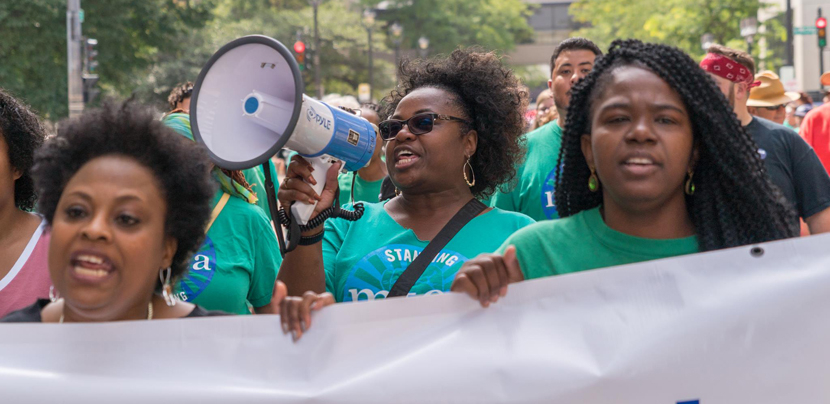How We're Surviving Right to Work: Conversations Are the Building Blocks for Milwaukee Teachers

Some unions in right-to-work states and sectors have high percentages of workers signed up as members. How do they do it? Photo: MTEA
Dispatches from the Front Lines of Right to Work
The open shop is the rule for private sector workers in 28 “right-to-work” states, for public sector workers in 25 states, and for federal workers all over this country. That means workers covered by a union contract get to enjoy the benefits of representation without being members or paying dues.
But even in states and sectors where membership is legally optional, some unions have high percentages of workers signed up as members. How do they do it? This month we asked union leaders representing:
For a short exercise to help your union start preparing to survive an open shop click here.
For public-employee unions in Wisconsin, an open shop isn’t even the worst of it. The anti-union Act 10, which Governor Scott Walker forced through in 2011, mandated annual recertification votes and all but eliminated collective bargaining.

Some unions gave up on staying certified at all—but not the Milwaukee Teachers Education Association. So far its 4,600 members include 69 percent of the district’s teachers and a narrow majority of educational assistants.
An organizing team of two staffers and six members on release time is working hard to raise those numbers, focusing on six schools per semester. Organizers tailor a plan based on the particular history and challenges at each school, but the universal building blocks are one-on-one conversations to find out members’ concerns, identify leaders, and ask people to join the union.
You have to learn to tolerate the discomfort of directly asking people to join, says Vice President Amy Mizialko. Especially in a district where school vouchers and private charter schools have already siphoned off a major share of the public schools’ budget, she tells co-workers that their students are counting on them: “The only way we can effect change for students and educators is being collectively organized.”
MOSTLY LISTEN

SUPPORT LABOR NOTES
BECOME A MONTHLY DONOR
Give $10 a month or more and get our "Fight the Boss, Build the Union" T-shirt.
In her organizing conversations, Mizialko tries to follow the 80/20 rule—listen 80 percent of the time, talk 20 percent. When she catches herself talking too much, she stops and asks a question. The best questions to get people talking are not yes-no but open-ended, such as, “What keeps you going in this job?” or “What do you wish you could change?” She listens to identify areas of common ground she can build on, workplace issues this person cares about, and which co-workers could have influence.
Often it takes multiple conversations to move someone. One union activist might get the conversation rolling, and another might follow up to seal the deal. Recently a rank-and-file organizer signed up “a guy that we’ve been trying to sign up for four years,” Mizialko said. “I was like, ‘How the hell did you do that?’”
The answer was “patience, persistence, and not writing him off,” she said. “Not making an enemy of this person, and being very curious and non-judgmental about why this person hadn’t joined.” It also mattered that the request came from a respected co-worker.
TAKE THE TIME
Tips from Milwaukee Teachers
- Learn to tolerate the discomfort of asking people, face to face, to join the union.
- Listen 80 percent of the time. Ask open-ended questions to identify which issues and co-workers might move this person.
- Anyone who shows up to a union action, such as a protest at a school board meeting, probably wants to join. Ask them.
- Take the time to hear out people’s workplace problems, and help them figure out how to solve them together with co-workers.
- What to say: “The only way we can effect change for students and educators is being collectively organized. If we don’t stick with our union and make it stronger then we’re giving up and we can turn the lights off now.”
The union fights simultaneously on large-scale issues—last fall members staved off the latest legislative scheme to convert Milwaukee public schools into private charters—and small ones in each school, like getting the principal to meet monthly and address teachers’ concerns.
Mizialko emphasizes there’s no substitute for helping members work together to solve their own workplace problems. At one school she was recently called to an emergency meeting with 20 members, where the volunteer building representative announced she was quitting her union role. Mizialko asked why. “I’m not going in there alone anymore,” the rep said.
It turned out that each month, after the union committee met, the rep was sent alone to represent their interests to the principal. “You’ve got to be kidding me,” Mizialko told the group. “That’s a great way to burn out your building rep. We need agreement that we’ll all go in together. Can we get that agreement?” After 90 minutes of talking it through, the rep agreed to stay on and the other members agreed to start backing her up.
“Walking alongside people as they do the things they’re afraid to do can pay a huge dividend,” Mizialko says. “It takes a lot of time, but it’s a very worthwhile investment. It’s so important to help people see how powerful they are, to pull that veil back: ‘You can do all of this and more.’”






